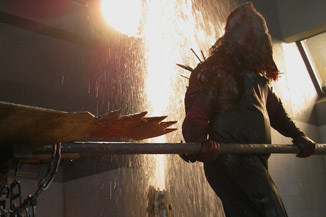What Went Right: Resident Evil Part II
By Shalimar Sahota
September 12, 2012
Just a few months after the theatrical release of Resident Evil: Apocalpyse, Capcom released on the Nintendo Gamecube what many would argue to be the videogame series’ magnum opus, Resident Evil 4 in in January of 2005. The game completely reworked the series. There were no fixed camera angles, instead offering an “over-the-shoulder” perspective, less scares, more action, and new enemies known as Los Ganados. It has been ported to many consoles, with a Nintendo Wii edition enhancing the game with motion controls, while in 2011 it received an HD makeover for the Sony PlayStation 3 and Microsoft Xbox 360. The game was a hit with fans, newcomers and critics, winning many “Game of the Year” accolades.
Following a completely reworked game, the third film, Resident Evil: Extinction, appeared to be a different take on the franchise. Anderson was still on board as writer and producer, but they brought in Russell Mulcahy (of Highlander fame) to direct with a production budget of $45 million. Taking inspiration from spaghetti westerns and Mad Max 2: The Road Warrior, it presented a very bleak representation of what’s happened to the world, something that doesn’t really get covered in the games (we see human survivors turning on each other).
With the virus having now spread across the globe, the film presented a post-apocalyptic world. Claire Redfield (a main character from the games Resident Evil 2 and Resident Evil: Code Veronica, played in the film by Ali Larter) leads a group of survivors across the desert. Midway they are joined by Alice, who is getting to grips with her telekinetic powers. Also included are those damn crows as well as Crimson Head zombies, referred to as the “Super Undead”.
The film is the most removed when compared to the videogames, and probably shouldn’t really have worked. The majority of it is also set in broad daylight (possibly taking its cue from the opening half of Resident Evil 4). The most absurd moment comes when Umbrella scientists attempt to domesticate a zombie, only it struggles with a toy (putting a star shaped block in a circular hole), causing it to get angry and kill the scientists.
As well as the Resident Evil name, the success of Extinction likely comes down to keeping to the videogame-like formula, something that is somewhat inherent in all of the films. Alice picks up items and clues (a diary which hints at a safe area in Alaska), new weapons (two kukri knives), disposes of zombies (the super undead kind), builds up her experience points (or telekinetic powers), and finally takes on the end of level boss (a mutated Dr. Isaacs/Tyrant). The film ended with a pullback shot revealing plenty of Alice clones. Who’s going to say no to another sequel with multiple Milla Jovovich’s?
Released in September 2007, it appeared to bring out the same number of fans in the US, with an opening weekend of $23.6 million. It followed the same pattern as the previous film, with a domestic total of $50.6 million. An overseas gross brought its worldwide takings up to $147.7 million. The film was a success.
Continued:
1
2
3
4




